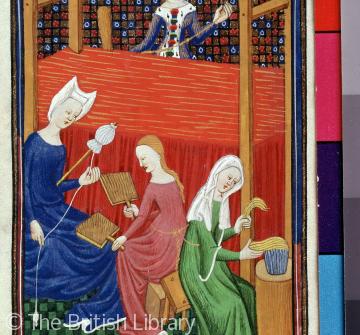Sheep and Wool Processing

Women processing wool from a 15th century manuscript
Sheep were washed and shorn in June and the wool sorted for sale. To be used for cloth manufacture it was carded and spun, either on a spindle and distaff or, from the early 14th century, on a spinning wheel. The woollen yarn produced was then woven. The earliest medieval looms were narrow, limiting the size of the finished cloth, but in the mid-13th century the broadloom was introduced, allowing cloths measuring 24 by 1¾ yards (21.9 x 1.6m) to be produced by two weavers sitting side by side.
Content generated during research for the paperback book 'Burford: Buildings and People in a Cotswold Town' (ISBN 13 : 9781860774881) for the England's Past for Everyone series



